Many adaptations for asexual propagation involve
underground plant parts. In some cases the structures are true roots, but most are
modified underground stems. (Remember back to the first week of the course, when we
compared the structures of stems and roots. One of the most important differences is that
stems have nodes, and roots do not.)Most of the
underground plant parts important in asexual propagation also function as food storage
structures. This type of food reserve is especially common among temperate herbaceous
plants, whose aboveground parts die back at the end of each growing season.
Tubers. Who among us hasn’t stored
potatoes for too long, or improperly, so that the "eyes" began to sprout?
It’s unfortunate for the chef, but a great botany lesson! The common potato
isn’t a root at all, but is a tuber—the
swollen tip of an underground stem. The "eyes" on a potato tuber are nodes from
which new plants, both stems and roots, can sprout. Most gardeners plant "seed
potatoes," which are pieces of potato (or small whole potatoes) that have at least
two or three eyes. As the plant grows, it uses the food reserves in the "seed".
Production of tubers is one way a plant can store
carbohydrates during the growing season. Then at the end of the growing season, the
aboveground portion of the plant dies back. The new tubers overwinter, and sprout again in
the spring. Two other plants that produce tubers are the Jerusalem artichoke and caladium.
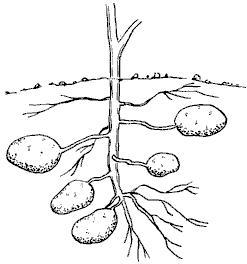 |
Potato plant, showing
tubers |
Tuberous roots and stems. Though
often grouped together with tubers, botanically these are different structures.
Tuberous
roots are enlarged secondary roots; because they are root tissue, not stem tissue,
there are no nodes or buds. Two familiar examples of plants with tuberous roots are sweet
potato and dahlia. Tuberous roots act as storage structures, allowing the plant to survive
a dormant period. In the spring, the new, adventitious shoot growth utilizes the food
stored in the roots, and the root shrinks and eventually disintegrates. The plant produces
new tuberous roots each season.
| Tuberous roots on dahlia |
 |
Sweet potatoes are usually propagated from
slips—these are adventitious shoots produced when the sweet potato is placed in a
moist location.
 |
Sweet potato, showing adventitious
shoots (slips) on tuberous roots |
Like tubers, tuberous stems are swollen sections of
stem; however, unlike tubers, they don’t occur at the tips of underground stems.
Rather, they occur on the main stem, often just below the soil level. Tuberous stems
generally have a vertical orientation with vegetative buds produced on the upper end (the
crown), and roots at the basal end. Examples include tuberous begonias and cyclamen.
Unlike tuberous roots, tuberous stems are perennial, and continue to enlarge every year.
With begonias, for example, you can dig up the "tubers", store them, and replant
them year after year.
| Tuberous begonia, showing sprout on
tuberous stem |
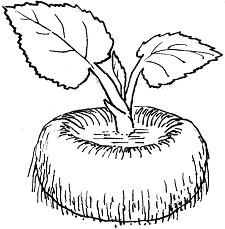 |
Rhizomes. A rhizome is an underground stem that grows
horizontally at or just below the soil surface. Rhizomes can be categorized into two
types: the thick, fleshy, compressed structure typified by the iris, and the slender,
elongated underground stems of lily-of-the-valley. Because they are stems, rhizomes have
nodes and buds along their length; new plants can arise at these nodes. Other examples of
rhizomatous plants include bamboo, sugar cane, and many grasses.
Quackgrass and poison ivy are two troublesome plants that
spread by rhizomes.
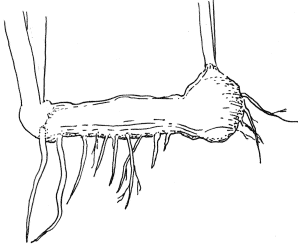 |
Iris rhizome |
Bulbs. A bulb is a modified stem that occurs in many
familiar monocotyledonous plants. A bulb consists of layers of fleshy leaf bases attached
to a shortened basal stem. The bulk of a bulb consists of concentric layers of bulb scales
which enclose the immature vegetative or flowering shoot. An onion is a example of a bulb
most of us have "dissected" in the kitchen; tulip, daffodil, amaryllis, lily,
and hyacinth are some of the more common flowering bulbs.
Plants with bulbs generally reproduce asexually by forming
daughter bulbs, or offsets, from buds occurring between the fleshy layers.
| Cross-section of tulip bulb, showing
buds |
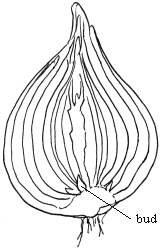 |
Corms. A corm is a swollen leaf base enclosed by dry,
scale-like leaves. In contrast to the layered scales of the bulbs, the bulk of a corm is
solid, with distinct, if compressed, nodes and internodes. Familiar examples of
corm-producing plants are gladiolus and crocus. As with the other structures we’ve
discussed, corms provide food for emerging shoots. The corm shrinks, and during the
growing season another corm is formed on top of the old one in preparation for the
following season. In addition, miniature corms, called cormels, develop on the base of the
corm. One or two year’s growth is required for cormels to reach flowering size.
| Gladiolus corm |
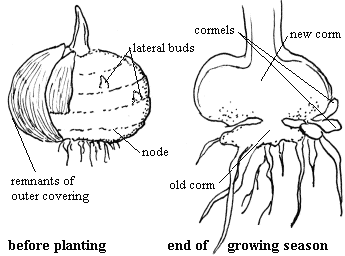 |
Now let’s look at a few aboveground plant parts
involved in asexual propagation.
